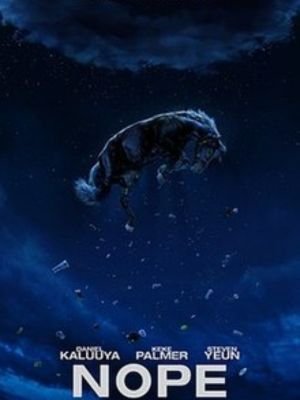
It is often said that show business can eat a person up. And Jordan Peele’s third movie takes that metaphor about as far as it can go. In his latest sci-fi horror, the film industry itself is a monster — but who does it chomp on, and for whose benefit? Nope sees the audience become a giant beast demanding to be fed personal and historical trauma — packaged up for them to consume. The film viscerally horror-ises the nightmare of being consumed by something you can’t comprehend — whether that’s a Lovecraftian flying terror or a national audience. But it also loves crew — in particular those working in less glamorous roles crucial to creating cinematic spectacle. American pathologies into demonic monsters are nothing new for Peele: Get Out found uncanny frights in white liberal racism via Guess Who’s Coming To Dinner and The Stepford Wives”; while Us reimagined C.H.U.D. (that great metaphor for class warfare and displacement) as itself.
Nope examines multiple meanings of “spectacle”. It unpacks cinema’s romanticisation of the American frontier, a site of historical trauma itself. White producers’ dominance over an industry feeding its movie-and-television machine with the misery of minorities is played just as terrifyingly straight as later more uncanny horrors; here, whiteness becomes another monster for Peele. But he’s not too worried about what Nope signifies: it satisfyingly resists the temptation of recent horror movies which overexplain their meaning, limiting themselves to one interpretation.
Daniel Kaluuya and Keke Palmer share wonderful chemistry as OJ and Emerald ‘Em’ Haywood, children of a famous Hollywood horse trainer who may or may not be related to the jockey in Eadweard Muybridge’s 1878 photography series “The Horse In Motion” (a key milestone in motion-picture history). Between Palmer’s manic energy clashes with Kaluuya’s cool stoicism, their close encounter with the unknown becomes an obsession and a possible answer to their inner turmoil — maybe even a route to fame. Another dynastic tragedy is included: Steven Yeun plays former child star ‘Jupe’ Park, who seeks refuge from a tabloid incident at a nostalgic, whitewashed Gold Rush-styled theme park. Equally intriguing is genre cinema legend Michael Wincott as a hermit cinematographer Quint-from-Jaws-type — ominously growling his way through renditions of the 1958 novelty alien song “The Purple People Eater” among other poetic and vaguely creepy turns of phrase.
While it shares Jaws’ desire to get something monstrous on film (the sky replacing the sea), Nope doesn’t confine itself to being straightforward pastiche; it embraces its influences but wants to do something new with them. Peele remixes a wide range of references with great skill and accuracy, including Lovecraftian incomprehensible terror, more niche genre fare like Ron Underwood’s Tremors, classic Hollywood and beyond — such as a direct reference to Akira via thrilling replication of the famous bike-slide shot (perhaps his tribute to a cancelled remake he was once attached to?).
Michael Abels, who often works with Peele, created a score that spans between light plucky tension and something much grander which hearkens back to classical westerns. Visually, Hoyte van Hoytema opens up the frame through IMAX photography and even with that newfound height, Peele is still able to manipulate and restrict perspective so well that we’re always left just missing out on seeing what’s going to scare us next (or letting our imaginations do the rest of the work). One such moment — featuring Steven Yeun — is among the most thrilling set-pieces all year long; it’s an incredible blast of pure visceral sci-fi terror. Van Hoytema and Peele never met a horror that didn’t feel claustrophobic enough so they’ve even made bright open spaces seem scary because characters can’t get high enough to see what’s coming for them.
Through all of this, Nope sees Peele define entertainment made for audiences as opposed to film-making done by yourself where you capture something impossible on camera and make it real. He does it by having Haywood ranch become mythic while showing how white supremacists used classic cinematic images throughout their manifest destiny propaganda – until now when Jordan just turns those same shots into something triumphant with Kaluuya wearing an orange The Scorpion King crew hoodie looking like a cowboy. In doing so he wrangles movie production history as liberally as any Haywood would horse around with one; bringing in every kind of cinema ever made only to tear them apart again more lovingly than ever before should be done during Nope which could also be seen both as an homage towards great films themselves while simultaneously poking fun at some its worst tendencies too
Also, Read On Fmovies
